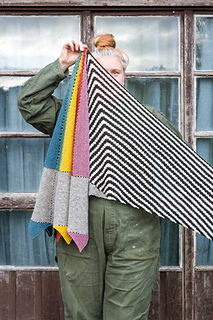patterns >  Anna Maltz's Ravelry Store
Anna Maltz's Ravelry Store
> Kleur






Kleur
Kleur means colour in Dutch. This asymmetric shawl is made up of two approaches to coloured yarn – dyed and undyed. While the shawl is worked in easy garter stitch (with a good smattering of simple eyelets), there are plenty of fun details and clever twists to keep things entertaining and the shawl reversible.
The shawl starts with a quarter of a circle. A mini-spectrum of seven wedges, shaped using simple short rows: just turning, no wrapping, to help create lines of decorative eyelets between the coloured wedges and make the shawl reversible. They are pictured in a rainbow, naturally dyed by Jules of Woollenflower, from deepest purple using indigo and cochineal to a pink dyed solely with cochineal. The wedges (and the spines that mirror them as the last step of the shawl) use a scant 10g to 15g: a perfect amount to showcase such a selection of naturally dyed yarns, or perhaps your own dyeing experiments. Ombré shades from a single dye bath would work equally as well as this fragment of a colour wheel. Of course you could also use up oddments or some prized mini-skeins.
Next, you knit on in monochrome shades, adding a whole lot more stitches and introduce a mitre. Regular cast offs along one edge make this the triangular half of the shawl, while the change of angle is highlighted by stripes in striking undyed Shetland black and white yarn – Chalk and Chalkboard, organic wool from Uradale farm in Shetland and spun for Garthenor as Ronas yarn. Decreases are worked along one edge, until the tip of the mitre is reached, at which point a third natural shade is added, the beautiful grey, Shale. This unites the triangular and circular sides of the shawl with a simple swathe of pure colour. Finally, the spectrum is revisited with spines.
SIZING
S (L) (sample pictured is an L)
MEASUREMENTS
Wingspan 176 (220)cm / 69¼ (86½)”
Centre of wingspan to bottom edge: 54 (68)cm / 21½ (26¾)”
YARN
Woollenflower, Masgot Fine (4ply/fingering; 100% wool (mix of Black Velay, Blanche du Massif Central and Bizet); 200m/219y per 50g/1¾oz)
You will need approximately 40m/44y per 10g/⅓oz (60m/66y per 15g/½oz) per yarn colour A-G.
Yarn A: Dark Purple (cochineal and indigo)
Yarn B: Sky Blue (indigo)
Yarn C: Sea Green (buckthorn and indigo)
Yarn D: Gold (pomegranate and weld)
Yarn E: Coral (madder)
Yarn F: Rust (madder)
Yarn G: Dusty Pink (cochineal)
Garthenor, Ronas (4ply/fingering; 100% wool (organic Shetland); 210m/230y per 50g/1¾oz)
If making the Large size, you will only be using around 20-40m/25-45y (10-20g/⅓-⅔oz) of the 2nd skeins of Yarns H, I and J.
Yarn H: Chalkboard x 1 (2) skein
Yarn I: Chalk x 1 (2) skein
Yarn J: Shale x 1 (2) skein
Yarn Note: If substituting yarn, the pattern benefits from being worked in a blockable yarn, to help all the shapes come together smoothly.
GAUGE
17 stitches x 34 rows = 10cm x 10cm / 4” x 4” over garter stitch after blocking.
SUGGESTED NEEDLES
4.5mm (US 7) circular needles, at least 80cm/32” in length.
Always use a needle size that will result in the correct gauge after blocking.
NOTIONS
7 stitch markers
tapestry needle
70 projects
stashed
106 times
132 projects
stashed
117 times
- First published: January 2019
- Page created: January 1, 2019
- Last updated: May 30, 2019 …
- visits in the last 24 hours
- visitors right now




